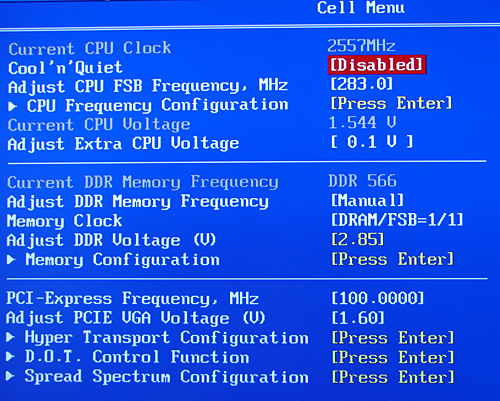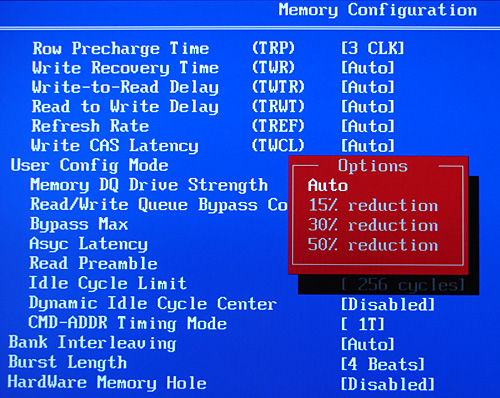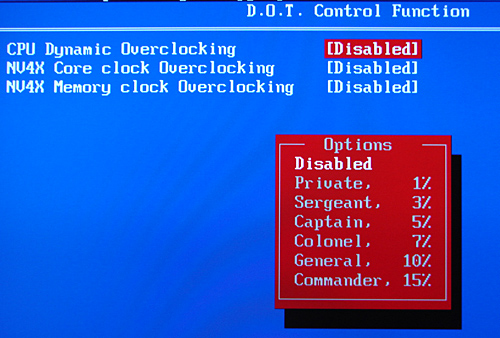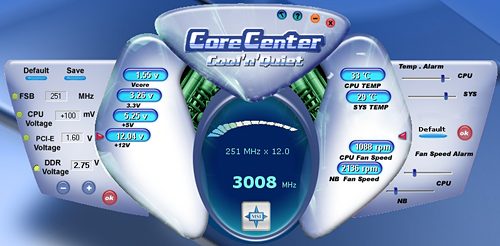Basic Features
The MSI K8N Diamond Plus is an upper-price ranged performance board targeted towards the AMD enthusiast user. The board ships with an extensive accessory package that includes rounded IDE cables, SATA cables, power connectors, SLI bridge card, Firewire backplate, and a 2 USB port/Diagnostic LED backplate. MSI also includes an extensive utility CD and documentation package.

Checking out the BIOS, the Cell Menu section is where most users will spend the majority of their time tweaking this board. While the selection of BIOS options is not as extensive as a DFI board, they are quite numerous and target the enthusiast user. The BIOS allows for CPU voltages up to 2.15V with the additional CPU voltage adjustment along with HTT bus speeds from 200 to 450 MHz. CPU ratios from 5x to 25x are also offered depending upon your CPU type, and the HTT multipliers for the NB and SB links can be independently set from 1X-5X.


The Memory Configuration section allows the user to control memory timing adjustments and dividers. The amount of manual settings available is impressive and without a thorough understanding of each setting, your board could be tuned incorrectly or left inoperable until the BIOS recovery system comes to the rescue. The BIOS allows for Auto settings that will determine the best timing attributes based upon memory type, divider, and bus speeds. We found in our testing the Auto setting would typically adjust the memory clock settings correctly if not a bit relaxed at times. Memory voltage settings are offered up to 3.20V and if you want to void the warranty on the board, MSI provides a switch block that will allow a voltage range from 3.35V to 4.10V.

The D.O.T. Control Function section allows the user to automatically set an overclocking level and then let the system worry about managing the various HTT, CPU, and RAM settings. The system provides for six different dynamic overclocking modes with percentages ranging from 1% to 15%. The BIOS also allows the same settings to be applied to certain NV40 based graphics cards. As a rule, all of these settings are disabled by default.

The PC Health Status section offers the ability to control fan speeds automatically. The BIOS allows the user to set temperature and fan speed targets for the Northbridge and CPU fans, though control and monitoring of the board's chassis fan headers absent. Unlike the BIOS settings from Abit, the MSI BIOS is lacking fan failure notification, automatic temperature-based shutdown settings, and low-RPM alarms.

MSI ships several applications with their board with the most interesting yet disappointing one being the Core Center application. Although advertised as an overclocking utility that one would find very useful, it can only adjust the Dynamic Overclocking settings along with certain voltage settings. The application in essence is a temperature and fan monitoring software utility with limited abilities to change BIOS level settings. However, unlike the BIOS, the user can set fan speed and temperature level alarm conditions for the CPU and Northbridge fans - assuming of course that you're willing to always have Core Center running in the background.
| MSI K8N Diamond Plus Specifications | |
| CPU Interface | 939-Pin Socket supporting AMD Athlon 64 / 64FX / 64X2 |
| Chipset | NVIDIA C51D - North Bridge NVIDIA nForce4 SLI - South Bridge |
| HTT Speeds | 200MHz ~ 450MHz in 0.5MHz increments up to 210HTT, 1MHz increments up to 450HTT |
| CPU Clock Multiplier | Auto, 5x ~ 25x in 1x increments (maximum multiplier dependent upon processor utilized) |
| Memory Speeds | Fixed Dividers - 1/1, 1/2, 2/3, 5/4, 5/6 |
| PCI Bus Speeds | Fixed at 33.33MHz |
| PCI Express Bus Speeds | 100.00MHz ~ 148.4375MHz, various increments |
| LDT Multipliers | Auto LDT to NB, 200MHz, 400MHZ, 600MHz, 800MHz, 1GHz - LDT to NB, NB to SB, SB to NB |
| LDT Link Speed | 8-bit, 16-bit |
| Core Voltage | Startup, 0.800V ~ 1.400V, in .025 increments, Vcore Adjustment +.05V ~ .75mV in .05V increments |
| DRAM Voltage | 2.65V ~ 3.20V, auxiliary switch for 3.35V~4.10V, .05V increments |
| Memory Slots | (4) x DIMM, max. 4GB, DDR 400/333/266, non-ECC, un- buffered memory, Dual Channel Operation supported. |
| Expansion Slots | (2) x PCI-E x16 (each slot operates in 1x16 mode in SLI) (2) x PCI-E x1 (1) x PCI-E x4 (2) x PCI 2.3 |
| Onboard SATA | NVIDIA nForce4: (4) x SATA 3Gb/s Silicon Image - SiL3132: (2) x SATA 3Gb/s (NCQ, Hot Plug) |
| Onboard IDE | NVIDIA nForce4: (2) x UltraDMA 133/100/66/33 |
| SATA/IDE RAID | NVIDIA nForce4: (4) x SATA 3Gb/s - RAID 0, RAID 1, RAID 0+1, RAID 5 SiL3112: (2) x SATA 3Gb/s - RAID 0, RAID 1 |
| Onboard USB2.0 | (10) USB2.0 ports (four I/O panel ports, three board headers for six more ports) |
| Onboard LAN | Marvell 88E1115 PCI Gigabit Ethernet PHY Marvell 88E8053 PCI-E Gigabit LAN Controller |
| Onboard Audio | Sound Blaster Audigy SE, 8-channel HD audio |
| Onboard Firewire | VIA VT6306 IEEE 1394 chipset - 1394A capable |
| Power Connectors | 24-pin ATX 8-pin ATX 12V 4-pin 12V (required for SLI or dual card operation) |
| Back Panel I/O Ports | 1 x PS/2 Keyboard 1 x PS/2 Mouse 1 x Audio I/O Panel 2 x RJ45 LAN 4 x USB 2.0 1 x Serial Port 1 x Parallel Port 1 x IEEE 1394 Port 1 x S/PDIF Coaxial Out 1x S/PDIF Optical Out - TOS Link |
| Other Features | DigiCell- Inclusive Monitoring / Configuration Program Live Update - Windows based driver/bios update utility Core Center - Windows based Monitoring / Overclocking Utility Mega Stick - MSI MP3 Program I-Speeder - Network Monitoring Utility CoreCell- Dynamic Overclocking |
| BIOS | AMI 3.0a (3/21/06) |
The MSI K8N Diamond Plus is an upper-price ranged performance board targeted towards the AMD enthusiast user. The board ships with an extensive accessory package that includes rounded IDE cables, SATA cables, power connectors, SLI bridge card, Firewire backplate, and a 2 USB port/Diagnostic LED backplate. MSI also includes an extensive utility CD and documentation package.

Checking out the BIOS, the Cell Menu section is where most users will spend the majority of their time tweaking this board. While the selection of BIOS options is not as extensive as a DFI board, they are quite numerous and target the enthusiast user. The BIOS allows for CPU voltages up to 2.15V with the additional CPU voltage adjustment along with HTT bus speeds from 200 to 450 MHz. CPU ratios from 5x to 25x are also offered depending upon your CPU type, and the HTT multipliers for the NB and SB links can be independently set from 1X-5X.


The Memory Configuration section allows the user to control memory timing adjustments and dividers. The amount of manual settings available is impressive and without a thorough understanding of each setting, your board could be tuned incorrectly or left inoperable until the BIOS recovery system comes to the rescue. The BIOS allows for Auto settings that will determine the best timing attributes based upon memory type, divider, and bus speeds. We found in our testing the Auto setting would typically adjust the memory clock settings correctly if not a bit relaxed at times. Memory voltage settings are offered up to 3.20V and if you want to void the warranty on the board, MSI provides a switch block that will allow a voltage range from 3.35V to 4.10V.

The D.O.T. Control Function section allows the user to automatically set an overclocking level and then let the system worry about managing the various HTT, CPU, and RAM settings. The system provides for six different dynamic overclocking modes with percentages ranging from 1% to 15%. The BIOS also allows the same settings to be applied to certain NV40 based graphics cards. As a rule, all of these settings are disabled by default.

The PC Health Status section offers the ability to control fan speeds automatically. The BIOS allows the user to set temperature and fan speed targets for the Northbridge and CPU fans, though control and monitoring of the board's chassis fan headers absent. Unlike the BIOS settings from Abit, the MSI BIOS is lacking fan failure notification, automatic temperature-based shutdown settings, and low-RPM alarms.

MSI ships several applications with their board with the most interesting yet disappointing one being the Core Center application. Although advertised as an overclocking utility that one would find very useful, it can only adjust the Dynamic Overclocking settings along with certain voltage settings. The application in essence is a temperature and fan monitoring software utility with limited abilities to change BIOS level settings. However, unlike the BIOS, the user can set fan speed and temperature level alarm conditions for the CPU and Northbridge fans - assuming of course that you're willing to always have Core Center running in the background.










42 Comments
View All Comments
OvErHeAtInG - Tuesday, April 18, 2006 - link
Let me be the devil's advocate here. I know AT reviews (and others) usually regard same-colored RAM slots to be "correct" for dual-channel operation, but for me it's always made more sense when it's like this MSI board--one color for each channel. Of course, it wouldn't be confusing if manufacturers just chose one standard color scheme and left it at that.Gary Key - Thursday, April 20, 2006 - link
We completely agree about having a standard color scheme. The majority of boards have different colors for dual channel operation so our comments are based this fact. A previous MSI board we tested followed this pattern and then they change it on this board. It is too confusing in my opinion when a single supplier cannot agree on a color scheme between board releases. This is certainly not an MSI only issue either. :)
Wesleyrpg - Tuesday, April 18, 2006 - link
Hmmm, is this common knowledge? One of my friends suffers from this so badly that we had to set up his cable modem for use the the USB port (yuck). Is there a workaround/beta drivers? I'm sure NVIDIA wouldnt want this leaked if it was true? Why havent they done anything about it? The current AMD driver 6.70 is about 6 months old now and still corrupts data. Damn them!!!!
Gary Key - Thursday, April 20, 2006 - link
Yes, this is fairly common knowledge and we have actually referred readers to NVIDIA for assistance. I do have a new set of drivers for the Business Platform system and will be testing them next week.
Wesleyrpg - Tuesday, April 18, 2006 - link
hmmm, seems NVIDIA have more than just an issue with their ActiveArmor, from what i have been reading theres also huge problems with the IDE/SATA file tranfers as well. Wish i'd know about these issues earlier, up until today i been recommending the NFORCE4, but with all these issues its hard to recommend them at all. Why hasnt any articles been written up on the MAJOR issues with the Nforce4 chipset?Per Hansson - Sunday, April 16, 2006 - link
Just replying to your message to me in the other mobo review "Please email me - I have the photographs. We are doing some revisions on the engine and could not get these in but I did take the photographs for you."I'm not the one that needs the pictures, I can identify the caps anyway... I was just thinking that it would be a nice addition to your articles, incase there where other readers that where interested in this too...
This board looks really nice though, United Chemicon KZG everywhere it seems, except for the Sanyo Polymers at the VRM and plenty more than what should "really" be necessary for a budget board like this... (okay, there looks to be one or four odd caps in the PCI section but they do oftenly not see very much ripple current so it should be ok)
tekkstore - Monday, April 17, 2006 - link
http://www.tekkstore.com">tekkstore.comAnnonymousCoward - Friday, April 14, 2006 - link
Macs still don't have a right mouse button? When will they put their stubbornness behind?goinginstyle - Wednesday, April 12, 2006 - link
I think you guys need to check your facts on the southbridge. According to the HardOCP article the board has the ULi 1575 southbridge. Are you sure the board has the nforce4 sli on the southbridge as that chipset is usually on the northbridge .Gary Key - Wednesday, April 12, 2006 - link
We will not comment in an open forum about another website's information that might or might not have been posted. However, I can ensure you this board utilizes the NVIDIA nForce4 SLI for the Southbridge (MCP) and the C51D for the Northbridge (SPP) as explained on the front page. If you still question our statements, then please visit MSI's website where the chipset information is available for this board - http://www.msi.com.tw/program/products/mainboard/m...">MSI K8N DiamondThanks!